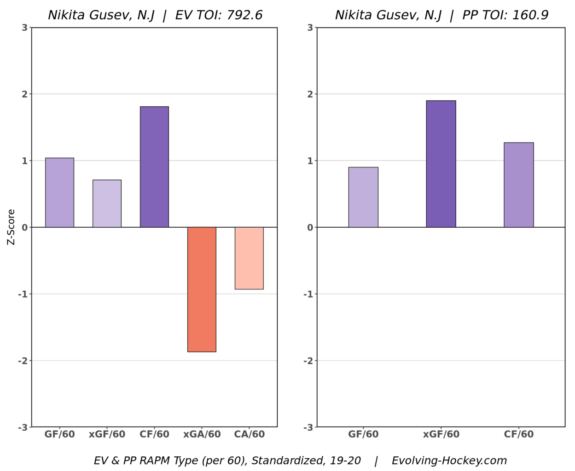There’s no doubt plenty of hockey writers, including myself, thought the New Jersey Devils won the 2019 offseason. They acquired P.K. Subban from the Nashville Predators for close to nothing. They also drafted Jack Hughes at the 2019 Entry Draft and signed Wayne Simmonds in free agency.
Of those additions, only Hughes showed any promise. Subban had the worst season of his career, and the Devils ended up trading Simmonds to the Buffalo Sabres at the trade deadline. But there’s one offseason acquisition I haven’t mentioned yet, and that’s Nikita Gusev.
The Devils obtained Gusev from the Vegas Golden Knights in exchange for a couple of draft picks. He got off to a slow start in his first NHL season, but it didn’t take long for him to show why he was the reigning KHL MVP. Here’s a look back at his season and what lies ahead for the skilled, Russian winger.
Gusev Overcame Difficult Start
North American rinks are smaller than what Gusev was used to playing on over in Russia. So there was always going to be a transition for him in the NHL. With that said, the change proved to be a bit tougher than first anticipated after he impressed during the preseason.
Gusev totaled just five goals and eight points in his first 20 games. And his underlying numbers were among some of the worst in the NHL too — he had a Corsi share (CF%) of 43.90% and an expected goals share (xGF%) of 41.96%. It also didn’t help that then-head coach John Hynes was using him in some odd line combinations, particularly on the fourth line.

But for as questionable as Hynes’ lineup decisions were, he was also responsible for getting Gusev going. Once he paired him with Blake Coleman and Travis Zajac, he started to look like the player that dominated the KHL. And once American Thanksgiving approached, he was in a total groove.
Since that time, Gusev totaled 36 points in 46 games (8 goals, 28 assists). He was the Devils’ most efficient five-on-five point producer during that stretch (2.25 points/60). And he was second on the team in CF% (50.9%) and sixth in xGF% (48.61%). There was no better playmaker than Gusev, as he averaged 1.50 primary assists per 60 minutes (A1/60). The next best was Jesper Bratt, with 0.74 A1/60.
If there’s a gripe with Gusev’s game, it’s his defensive play. But the Devils didn’t bring him to be a shutdown, defensive forward. They brought him in to impact the game on offense, and that’s what he did.

There was a time when this chart was entirely light to dark orange and even red at even strength. Gusev’s defensive impact only improved slightly. But where he saw significant improvement is on offense, as the lighter and darker purples show a positive impact (as is the case on the power play). That doesn’t happen without the way he played over the last 46 games. And if that stretch of play is any indication, he should be one of the Devils’ top performers in 2020-21.
What’s Next for Gusev
Gusev’s 36 points over his final 46 games come out to a 64-point pace over 82 games. There won’t be a learning curve at the start of next season, either. So he should get off to a much stronger start than he did in 2019-20.
But who Gusev plays with will be a bit of a mystery. There’s a good chance the Devils’ roster will look quite a bit different up front, too, so that only makes trying to predict his linemates tougher. With that said, he seemed to find good chemistry with Bratt down the stretch, a significant turnaround from the start of the season.
Related: Devils’ Palmieri a Model of Scoring Consistency
Both sample sizes are small, but in 58 minutes together from Oct. 1 – Feb. 16, Bratt and Gusev had a CF% of 37.5% and xGF% of 33.3% together. When they were placed on a line together towards the end of February, they had a CF% of 52.15% and xGF% of 51.76% in 108 minutes together. Bratt became the Devils’ best shooter behind Kyle Palmieri, and it wouldn’t a surprise to see Gusev, a pass-first winger, remain on a line with Bratt.
The question is, “who could play center with them?” Pavel Zacha fared well as their center in the final few weeks of the season, but he’s not a long-term solution on a scoring line. The Devils selected Hughes with the first overall pick for a reason. He may have had his ups and downs as a rookie, but an offseason of training and getting stronger should put him in a better spot to succeed moving forward.

If a new coaching staff comes into place and they’re hesitant to play Bratt, Hughes, and Gusev as a line, there are other options. Gusev had played left-wing his entire career until this season, so a move back to the opposite side shouldn’t be too problematic. Let’s say that happens, pairing him with Nico Hischier and Palmieri would be worth a look. They’re two of the team’s best defensive forwards, so they can help mask Gusev’s defensive shortcomings. And they have the offensive skill set to capitalize on his A-plus playmaking ability.
Related: Revisiting the Devils’ Trade for Alexander Mogilny
But regardless of where he plays, Gusev will be one of the Devils’ go-to offensive threats in 2020-21. His passing is second to none on the team, and there’ll be no worries about a transition like there was this season. He doesn’t play a physical game, so injuries shouldn’t be a major concern, either. Assuming the coronavirus doesn’t affect the start of next season, I’d expect him to play in almost all the team’s games and finish with 60-70 points on a top line.
* * *
Advanced stats from Natural Stat Trick, RAPM chart from Evolving Hockey